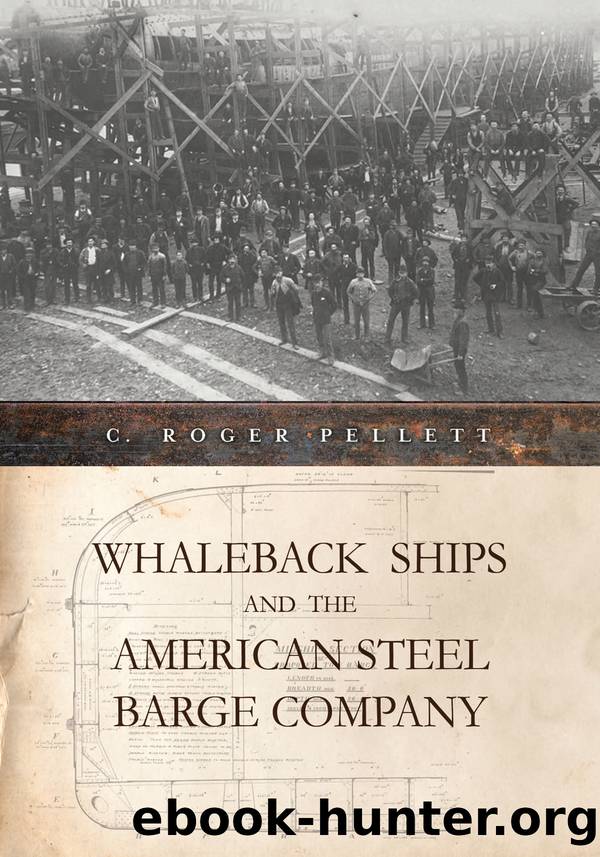Whaleback Ships and the American Steel Barge Company by Pellett C. Roger;

Author:Pellett, C. Roger;
Language: eng
Format: epub
Publisher: Wayne State University Press
A cross-sectional view of a whaleback barge or steamship fitted to haul package freight, in this case probably flour in barrels. Cargo is loaded through gangways in the side of the vessel and is stowed on two levels. The upper deck, known as a âtween deck,â would not be present on vessels designed for bulk cargo trades. A system of overhead pulleys on a common steam-driven shaft was used to lower cargo to the hold below. Source: Bowling Green State University Special Collections-Entry 988.
It is hard to understand how an experienced shipmaster like McDougall would fail to realize that vessels with the whaleback hull form would be poorly suited for the package freight trades. Naval architects V. N. Minorsky and R. J. Tapscott explained:
One of the principal factors conducive to profitable operation in the long run is the operatorâs ability to make his ships âfull and down.â
This means that the ship is down to her marks (Plimsoll) with all cargo cubic fully occupied. It is not the ability to obtain cargo for the vessel which is involved. âFull and downâ operation implies that the basic cargo-carrying characteristics of the ship are suited to her particular trade.33
For each commodity, there is a âstowage factorâ that lists the cubic feet occupied by one ton of cargo. The smaller the stowage factor, the heavier the cargo. âHeavyâ cargos, referred to as displacement cargos, weigh a ship down without filling it up. âLightâ cargos, referred to as measurement cargos, fill the ship up without weighing it down. In Britain, the dividing line between displacement and measurement cargos was fixed at 40 cu. ft./ton. Table 6 provides stowage factors for different commodities. The trick for the naval architect, when designing a ship to haul a light cargo, is to make full use of the shipâs displacement (cargo floating capacity) when her holds are completely filled. A shipâs displacement is determined by underwater dimensions and constrained by hull shape and environmental factors such as depth of channel and lock dimensions. A ship designed to haul light cargo needs an underwater volume only large enough to float its cargo and ensure adequate transverse and longitudinal stability, and a large above-water volume to stow bulky goods. Period illustrations of Great Lakes package freighters show that they typically had oversized (by bulk freighter standards) superstructures. Alternatively, a very heavy cargo will weigh the ship down to its desired draft without completely filling its underwater volume; its hull above water needs only be large enough to provide reserve buoyancy required for safety.
The idea behind the whaleback ship was to provide maximum displacement (underwater volume to float cargo) and minimum above-water volume to save cost and weight. Since package freight is a light cargo, the whalebacksâ small volume above water would have prevented them from hauling enough cargo to make them âfull and down.â
The inboard profile drawing for the Washburn and the Pillsbury shows cubic capacities for each of the shipsâ four lower cargo holds as well as the single upper cargo hold above the tween deck.
Download
This site does not store any files on its server. We only index and link to content provided by other sites. Please contact the content providers to delete copyright contents if any and email us, we'll remove relevant links or contents immediately.
Life 3.0: Being Human in the Age of Artificial Intelligence by Tegmark Max(4523)
The Sports Rules Book by Human Kinetics(3597)
ACT Math For Dummies by Zegarelli Mark(3569)
The Age of Surveillance Capitalism by Shoshana Zuboff(3434)
Blood, Sweat, and Pixels by Jason Schreier(3141)
Unlabel: Selling You Without Selling Out by Marc Ecko(2995)
Urban Outlaw by Magnus Walker(2953)
Hidden Persuasion: 33 psychological influence techniques in advertising by Marc Andrews & Matthijs van Leeuwen & Rick van Baaren(2793)
The Pixar Touch by David A. Price(2746)
Bad Pharma by Ben Goldacre(2737)
Project Animal Farm: An Accidental Journey into the Secret World of Farming and the Truth About Our Food by Sonia Faruqi(2668)
Brotopia by Emily Chang(2596)
The Content Trap by Bharat Anand(2499)
Slugfest by Reed Tucker(2426)
The Airbnb Story by Leigh Gallagher(2380)
Kitchen confidential by Anthony Bourdain(2323)
Coffee for One by KJ Fallon(2019)
Smuggler's Cove: Exotic Cocktails, Rum, and the Cult of Tiki by Martin Cate & Rebecca Cate(1996)
Beer is proof God loves us by Charles W. Bamforth(1937)
